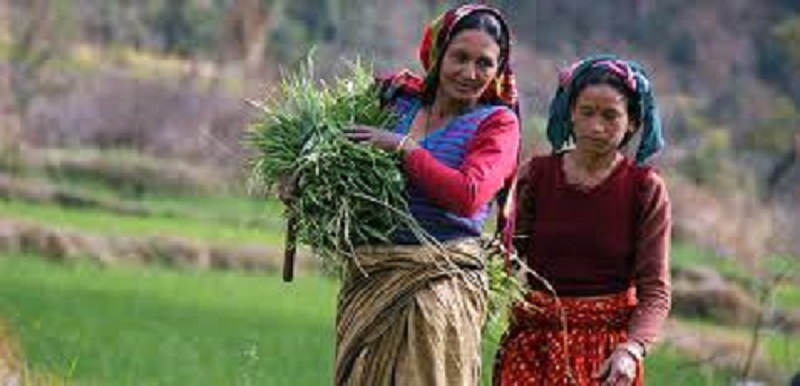- December 19, 2018
- Posted by: Richa Joshi
- Category: Featured, GENDER INEQUALITY, LABOUR POLICY & REFORMS, Latest Work, SOCIAL ISSUES

The land is one of the most significant assets which determine the social status and economic prosperity in the community. The associated rituals construct an emotional bond between the community and land. In the present article, the relationship between the land and gender has been focused by underscoring the role of gender concerning asset holding and the inheritance pattern of land. The various aspects such as land allocation to women, the female-headed households and challenges faced by women in access to land would be covered.
Jacobs (2013) explored the role of gender in controlling access to the agricultural land by taking the case studies from various countries such as Chile and Nicaragua and encapsulated the vital role women hold in the indigenous farming practices. In many countries, women play an essential part in the agrarian sector when males are occupied in other economic activities Razavi (2003). According to the study of Ursula Sharma (1980) in North India, the land is perceived as a shared resource by the women, but the contribution in such joint resources leads to informal work negotiation. Thus women are generally denied ownership and control of the land and considered mainly as agricultural labour, landless labour, small or poor peasant and middle peasants (Deshpande, 2008). The irony is well described by Alaka and Chetna (1987) in their study in Bihar which shows how money is wasted in liquor or fritter by the males and females managing agriculture fields are deprived of land titles.
In India, land ownership by women is not more than 2% (Agarwal, 1994, as cited in Velayudhan, 2009). One of the critical factors affecting the women’s economy is a gender gap in the inheritance of property. Lack of effective property rights not only subordinate women economically but also socially and politically. Therefore, Bina Agarwal (1994) in her study in India argued the importance of giving land rights to women and asked for the claims to be demanded by women that are legally and socially recognized and enforceable by an external and legitimized authority.
A discrepancy has been perceived in the inheritance of land in different states which is due to the variation in the enactment of land laws. The inheritance pattern of land varies further on the basis of region, religion and community. The general practice of inheritance of land in Uttarakhand is mainly through the male line descents. Women’s inheritance rights in Uttarakhand are dependent on tenurial laws. These rights are governed by Uttar Pradesh Zamindari and Land Reform Act, 1950 which shows a strong preference for agnatic males. The land is transferred to women only in the absence of a male heir, daughters and sisters are recognised very low in the order. A woman holds a fragile position considering the ownership of land. After a woman’s death, the holding does not go to her female heirs but to the male heir of the last male landowner. The woman can lose her husband’s land if she remarries or fails to cultivate it for a year or two. The following laws show strong gender bias where the daughter has no rights in the agricultural land when the sons are alive. The Hindu Succession Amendment Act 2005 has tried to waive off such discriminatory laws in the agricultural landholding, but the implementation is weak and the practice is still not prevalent in the State.
According to the 2011 census, in the state of Uttarakhand, 64 percent of women are cultivators, and 8.84 percent are agricultural labour whereas only 20.82 percent of men are cultivators and 11.23 percent are agricultural labours. The data shows the significant contribution of women in the informal economy in Uttarakhand (Census 2011 as cited in Doval, 2015)
In the past different waves of protest stroke in the Tarai region for giving land rights to women. The very first initiative was Mahila Mazdoor Evam Laghu Kisan Morcha organised in 1989 with the support of disha[1] (Saharanpur, UP), due to the lack of full participation, the movement declined. After a gap of many years, the next campaign called Aaroh[2] was launched in June 2006 with the support of other organisations functional in the same regional belt for recognition of women as farmers. In continuation of this, Mahila Kisan Hit Adhikar Yatra was organised and the procession covered five-gram panchayats in January 2007. Due to lack of mass participation and the sporadic nature of the campaign, the movement lost its momentum.
The land holds the most pivotal place in the socio, economic and religious life of the tribal economy which establishes a passionate bond between the community and land. The ownership and use of land in the tribal community is a symbol of identity and solidarity. For the ground understanding, a survey was conducted by the researcher in the village called Purangarh in the district Udham Singh Nagar, Uttarakhand to comprehend the interface between land and gender in the tribal community of Uttarakhand. The village is heavily dominated with a tribe called the Rana Tharu. The Rana Tharu are considered as the originals inhabitants in the Tarai region of Uttarakhand and are the patrilineal community where land is inherited from male to male. The marital status of a Rana woman determines no ownership on her husband’s land. When the marriage dissolves due to the death of the husband or divorce, the women are overcome by her in-laws. In the cases of divorce, she loses her rights at her husband’s household and land, and as a widow, she has to rely on her sons. In case the women have no offspring, she’s given no rights to use her deceased husband’s land.
Challenges and threat faced by women to access her husband’s land:
Case Study 1: Savitri Devi, age around 85 years lives in Purangarh village, Udham Singh Nagar district, Uttarakhand. Her husband owned around 20 hectares of land and was one of the most prominent landholders in the village. He died when she was 27 years old and had one girl child. Husband’s brother tried to bully her and wanted to take away the share as her name was not mentioned anywhere in the khata khatoni[3] or land records which are taken care by the Patwari in the village. Most of the land was taken away by her brother-in-law irrespective of the laws related to land rights mentioned by the state for widows in the state. The Zamindari Abolition and Land Reform of 1950 say when a male landowner dies the right to inherit the land goes to his son. In the absence of a male heir, the deceased wife will inherit the land whereas the married daughters are completely excluded from the inheritance rights. The rights can even access by deceased brothers but not by his daughter. The Hindu Succession Amendment Act 2005, made a change in land inheritance law, now the widow, as well as deceased daughters, can have inheritance rights in the property. She unwillingly agreed with the gram panchayat decision which settled the dispute between her and in-laws by giving her a few biswa[4] of land which is almost negligible when compared to 20 hectares of land. Savitri Devi and her daughter were not acknowledged of updated legal acts to fight for their rights. Today she is managing her livelihood on a very small piece of land and is dependent on her daughter for her basic daily needs.
Case Study 2: Bimla Rana who is 38 years is the wife of an alcoholic husband, she is facing the tyranny of violence every day. Presently the family owns 30 biswa of land, and around 15 biswa was sold previously by her husband to pay back the loan for buying the liquor. She works on the field with the help of her mother in law to provide the basic livelihood to the three children and the family. During the paddy season, she works as wage labour on others farm to support the education of her children. After working day and night, she is often abused by her husband. Her husband has borrowed money for liquor from almost every house in the village. In order to pay back the borrowed money most of her household assets are kept as collateral. When the researcher asked her to claim for her land rights, she refused and said the land is in the name of her husband. She has no ownership, and if she reports the case in the police station the husband would not even let her come home, and she will become homeless. On asking further, she told that many times she approached Sabha Patti[5] , but she’s been refused to endow land saying in the Rana community, the patrilineal system of inheritance is practised where property, including land, is inherited only through the male bloodline for the protection and continuity of a decent group.
As observed in the above case studies how women’s status is dependent either on their father’s or husband’s position, the economic position of women is vicarious and resonates with her marital status. Getting married in rich family upgrade her position whereas divorce and widowhood can make her subjugated and bullied by male members in the household. There is an alarming need for a gender-focused approach to meet the changes required in the inheritance of land in Uttarakhand. Landowning and formal titles by women can strengthen them to face the vulnerabilities. The government programmes about land are mostly constructed by giving the powers to male heads of the household which has further taken away the decision making of females. Therefore, gender mainstreaming and valuations of policies with efficient administration can secure rights and opportunities to women in the rural economy and especially for less educated tribal communities.
References:
- Agarwal, B. (1994). A field of one’s own: women and land rights in South Asia. Cambridge: Cambridge University Press.
- Alaka and Chetna. (1987). When Women get Land- A Report from Bodhgaya, Manushi, 40, 1-25.
- Deshpande, R. (2008). Contract Farming and Tenancy Reforms: Entangled without Tether. New Delhi: Published for Centre for Rural Studies, Lal Bahadur Shastri National Academy of Administration, Mussoorie by Concept Pub. Co. [ISBN: 9788180695322(HB)], pp.260.Price INR 375.
- Jacobs, S. (2013). Gender, Land and Sexuality: Exploring Connections. International Journal of Politics, Culture, and Society, 27(2), 173-190. http://dx.doi.org/10.1007/s10767-013-9156-5
- Razavi, S. (2003). Agrarian change, gender and land rights. Oxford: Blackwell
- U, Sharma. (1980). Women, Work and Property in North West India. London: Tavistock Publications.
- Velayudhan, M. (2009). Women’s Land Rights in South Asia: Struggles and Diverse Contexts. Economic and Political Weekly, 44(44), 74-79.
- https://www.kaanoon.com/198388/daughters-property-rights-in-uttarakhand Retrieved on (15/12/2018, 9.20 PM)
- https://www.livemint.com/Politics/jA2vzjd3P3C99rpPjouehP/The-invisible-hands-tilling-the-fields.html Retrieved on (19/12/2018, 10.15 PM)
Endnotes:
[1] Disha is a civil society organisation working in the four districts of Uttar Pradesh and Uttarakhand.
[2] Aaroh is a collective campaign for demanding justice and asserting rights for women farmers in the Tarai. The campaign is supported by the regional organisation called Disha and is coordinated by an organisation called Gorakhpur Environmental Action Group and Oxfam Trust.
[3] Khata Khatoni is the land records where the details such as the name of the owner and measurement of the field are mentioned.
[4] Biswa is a unit of land which is widely used for measurement in Uttar Pradesh and Uttarakhand. Biswa is a small unit of measurement. 1 Bigha = 20 Biswa.
[5] Sabha Patti is the political head in the village who is also known as Gram Pradhan

